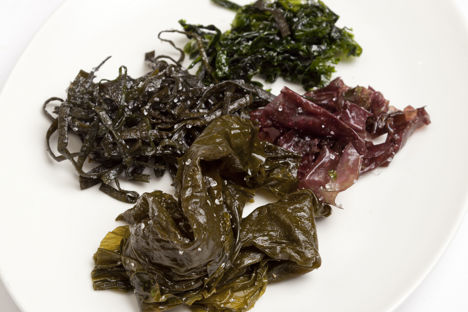Seaweed is something most people associate with the murky depths of British shorelines, tickling your legs while you paddle and generally looking a bit sinister rising up from the seabed. Perhaps its abundance and familiarity has caused many of us to overlook it as a food - and what a shame that is. There are a plethora of edible seaweed varieties, from the rather mysterious-sounding native species spiral wrack, Irish moss and gutweed to the Japanese staples of kombu and nori.
What to look for when buying seaweed
Seaweed can be foraged, with a plentiful supply on the UK’s coastline. If you want to forage seaweed, make sure you do you homework and try to go foraging with an experienced forager first. Foraged seaweed needs to be washed thoroughly in water before cooking.
With its recent increase in popularity, many varieties of seaweed are available online or in shops, from fresh and dried native species to packs of laverbread paste. Some dried seaweed varieties now come in easy to use seaweed flakes, and flavourful blends are available to add a delicious umami seasoning to dishes. Buy seaweed from a reputable dealer who collects seaweed in waters monitored for pollution. It’s best to buy seaweed that has been collected by hand, as this minimises the impact on the environment.
How to cook seaweed
The type of cooking method used for seaweed depends greatly on the type of seaweed used and the effect you are after. Dried seaweed is better for making strongly umami-tasting stocks, while fresh seaweed varieties can be cooked and served alongside a seafood dish or in soups. Most fresh seaweeds can be cut up and deep-fried for a nice crispy accompaniment, taking from 3-20 seconds depending on the variety used - deep fried sea grass makes a particularly light and attractive side, as Nathan Outlaw demonstrates in his ling recipe.
Delicate varieties such as sea lettuce benefit from quick, gentle cooking techniques, or can be eaten raw. Sea lettuce, due to its sheet-like structure, can also be used to wrap fish for cooking, imparting a second flavour of the sea. It is also very attractive on the plate - a bright emerald green colour.
Thicker brown varieties such as channel wrack and spiral wrack are just as versatile - they can be simply steamed before incorporating into larger dishes, blanched or cooked for longer for the base of a vibrant seaweed soup. Some seaweed varieties do need to be cooked for a couple of hours before eating to achieve the best flavour, so make sure you are cooking with the right type of seaweed.
Dried seaweed is also immensely versatile - Japanese kombu (kelp) forms the base of dashi stock, which is the heart of many Japanese dishes. Dried seaweed can also be blitzed and used as a potent umami-flavoured seasoning for a range of dishes.
The most common form of seaweed, nori (also known as laver) is a widely found variety. This type of seaweed comes in crisp thin sheets that are ready to eat. It is mainly used to make hand-rolled sushi, but can also be deep-fried or blitzed and used as a seasoning, or of course, used to make laverbread.
What seaweed goes with
The most obvious accompaniment for seaweed is of course, seafood. It need not just be served as a side, though this is also delicious. Adam Stokes blitzes dried kombu and uses it as a seasoning for his pollock recipe, while Nuno Mendes uses a similar method to cure the cod in his recipe. Daniel Clifford makes a dashi stock and turns it into a jelly - the perfect accompaniment for his peas and prawns recipe.
Richard Corrigan’s turbot and mussels recipe is a veritable taste of the sea, incorporating seaweed, sea lettuce and sea vegetables simply cooked in sauce. For a playful taste on the Welsh classic, Adam Stokes fills ravioli with laverbread. Serve fish chopped with crispy deep-fried seaweed, as Nathan Outlaw does in his cider cured trout recipe.
Get in touch
Please sign in or register to send a comment to Great British Chefs.



